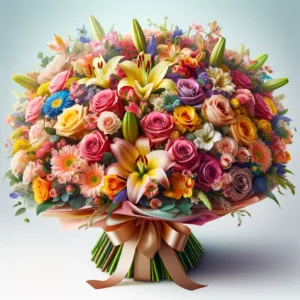Discover the ethereal beauty of a Cuckooflower Bouquet, featuring delicate blooms in shades of pale pink and lilac. Our handcrafted arrangements showcase the graceful charm of Lady’s Smock, creating a unique and natural bouquet perfect for any occasion. Bring the enchantment of wildflowers into your space with our thoughtfully curated Cuckooflower bouquets.
Introduction
Here at Cuckooflower Bouquets, nature’s delicate beauty is at the forefront of our beautiful bouquets. These bouquets, which are characterized by delicate Lady’s Smock blooms in lilac and pale pink shades, offer a unique combination of elegance and simplicity. Discover the ethereal beauty of Cuckooflowers, expertly arranged to add a touch of nature to your décor. No matter whether you are looking for a thoughtful gift or a delightful addition to your surroundings, our Cuckooflower Bouquets will captivate you with their natural allure and timeless appeal.
History of Cuckooflower bouquet
It is commonly known as cuckoo flower, lady’s smock, mayflower, or milkmaids, and belongs to the Brassicaceae family. “Pratensis,” the Latin term for “meadow,” is its specific name.
Description
With pinnate leaves measuring 5–12 cm in length with 3–15 leaflets approximately one centimeter in length, this herbaceous perennial reaches a height of 40–60 cm. Its leaves are devoid of hair, reaching 40–60 cm in height. A spike of flowers, 10–30 cm long, boasts four pale violet-pink petals (occasionally white), with either a short or longish style. It thrives in close proximity to water, making it an attractive addition to natural landscapes.
Etymology
As a result of its synchronization with the arrival of the first cuckoos each spring in the British Isles, the name “cuckoo flower” comes from its flowering period. It is also possible that the term was associated with froghopper froth, rather than cuckoo spit, a froth produced by the bug.
Distribution
The species is widespread throughout the British Isles, and it can be found in all 40 “vice-counties” in Ireland, as established by Praeger in 1901. Furthermore, as a result of cultivation, it has become naturalized in North America, posing a threat to certain European regions, including parts of Germany.
Cultivation
As an ornamental plant, Cardamine pratensis attracts the orange tip butterfly (Anthocharis cardamines). It is also an important part of wildlife-friendly gardens. Formerly used as a watercress substitute, it faces threats in some parts of Europe.
Folklore
Due to its folkloric significance, the plant was previously considered sacred to fairies, and bringing it indoors was considered unlucky. It was therefore excluded from May Day garlands for this reason.
Additional Information
Cardamine pratensis has been designated as the county flower of Cheshire, England, and can be found in gardens across the world. The accompanying gallery attempts to illustrate its presence in a variety of regions, emphasizing both its botanical and historical characteristics.
Cuckooflower Bouquet
Featuring the delicate and dainty blossoms of the Cuckooflower plant, a Cuckooflower bouquet would be an appealing arrangement. It is also known as Lady’s Smock (Cardamine pratensis) because of its pale pink to lilac flowers. It can be found in damp meadows and grasslands.
It is possible to create a bouquet of Cuckooflowers by gathering these flowers and their slim stems and arranging them in a straightforward, natural manner, allowing the graceful beauty of the blooms to shine through. If you wish to enhance the overall aesthetic value of the Cuckooflowers, consider complementing them with other wildflowers or greenery.
Ensure that you pick the flowers responsibly, respecting the natural environment and following local regulations. The result will be a lovely, yet understated bouquet, suitable to bring the outdoors inside or as a gift for someone who enjoys the charm of wildflowers.
Type of Cuckooflower Bouquet
It is a delight to express nature’s beauty through cuckooflower bouquets, which feature delicate and captivating blooms from the Cuckooflower plant. They are cherished for their ethereal charm and are popular for many occasions. Here we explore the different types of Cuckooflower bouquets that can add a touch of elegance to any setting.
1. Classic Cuckooflower Bouquet:
Known commonly as Lady’s Smock or Cuckooflower, the soft, pale-pink blossoms of the Cardamine pratensis flower make up the classic Cuckooflower bouquet. In addition to being timeless and elegant, this arrangement is a good choice for weddings, anniversaries, and romantic celebrations in general.
2. Wildflower Mix Cuckooflower Bouquet:
If you are seeking a more rustic and natural look, consider a Cuckooflower bouquet incorporating a mix of wildflowers. By blending the delicate Cuckooflower blooms with other native flowers, the arrangement takes on an untamed quality that reflects the untamed beauty of the countryside.
3. Spring Garden Cuckooflower Bouquet:
The Cuckoflower bouquet showcases a variety of springtime blooms in an effort to celebrate the arrival of spring. A vibrant, cheery arrangement is created by combining the subtle hues of the Cuckooflower with flowers that symbolize renewal and new beginnings, including daffodils, tulips, and other seasonal flowers.
4. Monochromatic Elegance:
You can achieve a sophisticated and modern look by choosing a monochromatic bouquet of Cuckooflowers. Choose blooms in varying shades of pink, from pale blush to deep magenta, for a stunning visual impact. It is a suitable arrangement for formal events or a stylish gift for someone with refined tastes.
5. Cottage Garden Charm:
Choosing a Cuckooflower bouquet that incorporates a variety of cottage-style flowers will help you capture the quaint beauty of a cottage garden. Think of daisies, lavender, and baby’s breath arranged in a charming manner. An intimate and relaxed setting is ideal for this type of bouquet.
6. Whimsical Cuckooflower Cascade:
You can create an enchanting display with a cascading Cuckooflower bouquet. The flowers gracefully spill over the edges of the vase, creating a whimsical, fairy-tale-like effect. This style is particularly popular with weddings and outdoor events with a bohemian theme.
Uses and Occasions

Due to their enchanting beauty and subtle charm, cuckooflower bouquets, featuring the delicate blooms of the Cardamine pratensis, have become a popular option for various occasions. These bouquets can serve as an elegant and versatile floral accent for a variety of uses and events, ranging from weddings to intimate gatherings. Let us explore the diverse occasions where a Cuckooflower bouquet would be appropriate.
1. Weddings and Romantic Celebrations:
Adding a touch of romance and sophistication to bridal bouquets, bridesmaid arrangements, and floral decorations with cuckooflower blooms is a timeless tradition for weddings and other romantic celebrations. In addition to complementing the joyous atmosphere of weddings, the Cuckooflower symbolises purity and the beginning of a new chapter with its gentle beauty.
2. Spring Festivities and Easter Celebrations:
Cuckooflower bouquets are perfect for spring festivities and Easter celebrations as their blooming season coincides with spring. It is a wonderful choice for Easter centerpieces, brunch decorations, and any other celebration celebrating the vibrancy of the season because the delicate flowers evoke a sense of renewal and freshness.
3. Garden Parties and Outdoor Events:
Cuckooflower bouquets are suited to garden parties and outdoor events because of their whimsical and natural allure. These bouquets bring a touch of nature indoors, creating a seamless connection with the outdoors, whether they are used to decorate tables for a garden tea party or to enhance a summer evening’s ambiance.
4. Gifts for Loved Ones:
Cuckooflower bouquets are thoughtful and meaningful gifts for loved ones on many occasions. These bouquets are an elegant and unique way to brighten someone’s day or celebrate a special moment in their life. The gentle beauty of these flowers conveys heartfelt sentiments, whether they are expressing love, gratitude, or best wishes.
5. Corporate and Formal Events:
You will be able to add a touch of sophistication and refinement to corporate events or formal gatherings with Cuckooflower bouquets. Due to their elegant and understated beauty, they create an aesthetically pleasing and welcoming environment at office receptions, conferences, and formal dinners.
6. Wellness and Healing Spaces:
It has been shown that the inclusion of Cuckooflower bouquets in wellness spaces and healing environments can promote a sense of tranquility and calm. The association of Cuckooflower with medicinal properties in historical contexts enhances the symbolic value of these bouquets in spaces dedicated to relaxation and well-being.
DIY Cuckooflower bouquet
This beautiful flower, which is also called Lady’s Smock, lends itself beautifully to the creation of a bouquet that reflects your style and creativity. The stunning blooms of the Cardamine pratensis, also known as Cuckooflower, make an ideal DIY project. This guide will assist you in crafting a Cuckooflower bouquet.
Materials Needed:
- Freshly picked Cuckooflowers (ensure they are pesticide-free)
- Pruning shears or scissors
- Floral tape
- Ribbon or twine
- Foliage (optional, for added texture)
Step 1: Gather Your Materials:
Obtain a bunch of fresh Cuckooflowers from a pesticide-free location. Make sure you have all the necessary materials on hand, such as pruning shears, scissors, floral tape, and any additional foliage that you might wish to include in your bouquet.
Step 2: Prepare the Blooms:
Using pruning shears or scissors, trim the stems of the Cuckooflowers to the length you desire. Remove any excess leaves from the lower part of the stems in order to maintain the neat appearance of the bouquet.
Step 3: Arrange the Flowers:
You should begin by choosing a focal point for your bouquet. Arrange the Cuckooflowers in your hand. Add more items gradually so that the arrangement is balanced and visually pleasing. Consider varying the height of the flowers for an organic appeal.
Step 4: Add Foliage (Optional):
Including complementary foliage in your bouquet can add extra texture and harmony. You can place the foliage strategically among the Cuckooflowers, creating a harmonious balance. By incorporating complementary foliage into your bouquet, you can make it your own.
Step 5: Secure the Stems with Floral Tape:
When you are satisfied with the arrangement, secure the stems together using floral tape. Be sure to start at the top of the stems and wrap the tape tightly around, working your way down. This will ensure that the bouquet maintains its shape and will remain in place.
Step 6: Trim the Stems:
The bottom of the stems should be trimmed to create an even base for your bouquet, not only enhancing its appearance but also ensuring that the stems will rest evenly in a vase or container.
Step 7: Tie with Ribbon or Twine:
Make a finishing touch by adding a ribbon or twine around the floral tape to conceal it and to add a decorative element to your DIY Cuckooflower bouquet. Make sure that the ribbon color compliments the hues of the flowers.
Step 8: Enjoy Your Handcrafted Bouquet:
As soon as you have completed this DIY Cuckooflower bouquet, you may display it or gift it to friends and family. You can place it in a vase with water or share it with friends and family, knowing that you have created an arrangement that is both unique and personally meaningful.
FAQ’s
As a symbol of spring and new beginnings, the Cuckooflower was commonly associated with May Day celebrations and other spring festivals. The delicate yellow blossoms of these flowers were commonly used to adorn May poles in traditional stories and beliefs. Cuckooflower crowns were commonly adorning the May poles as young girls danced joyfully around the May pole during May Day festivities.
There is a piquant taste reminiscent of mustard or wasabi, while the floral taste is reminiscent of cress with hints of sweet and subtly spicy flavors.
It is a perennial herb belonging to the Brassicaceae family which is known as the cuckoo flower, mayflower, or milkmaid. It is native to most of Europe and western Asia. A common translation of its Latin name is “pratensis,” which refers to a meadow, reflecting its native surroundings.
There are numerous slender leaflets in the upper leaves of cuckooflower (Cardamine pratensis), which have pinnate structures and a large terminal leaflet. The basal leaves are arranged in a rosette. In addition to the pale lilac blooms, which can sometimes be white, this plant has notched petals that measure 12 to 18 mm, with yellow anthers. It thrives in damp pastures, marshes, and along river and pond margins.
It is believed that when the first sound of the cuckoo is perceived by the right ear, it is a sign of good fortune in all of the person’s endeavors throughout the year. Conversely, if the cuckoo is heard by the left ear, the opposite effects are predicted.
Conclusion
The Cuckooflower bouquet stands as a testament to the delicate and enchanting beauty found in nature. Due to its subtle, yet captivating blooms, this flower is suitable for a variety of occasions, ranging from weddings and romantic celebrations to spring festivities and thoughtful gifts. As a result of the rich symbolism and cultural significance woven into the fabric of the Cuckooflower, its appeal is heightened.
The Cuckooflower bouquet embodies the timeless elegance of floral expressions, whether it is a centerpiece for formal events or a natural addition to DIY arrangements. By embracing the artistry and symbolism behind these bouquets, we are able to connect with nature’s cycles, symbolizing renewal, femininity, and the timeless beauty of simplicity.







